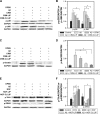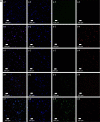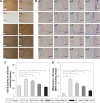Wheat germ agglutinin-conjugated liposomes incorporated with cardiolipin to improve neuronal survival in Alzheimer's disease treatment
- PMID: 28280340
- PMCID: PMC5340244
- DOI: 10.2147/IJN.S128396
Wheat germ agglutinin-conjugated liposomes incorporated with cardiolipin to improve neuronal survival in Alzheimer's disease treatment
Abstract
Curcumin (CRM) and nerve growth factor (NGF) were entrapped in liposomes (LIP) with surface wheat germ agglutinin (WGA) to downregulate the phosphorylation of kinases in Alzheimer's disease (AD) therapy. Cardiolipin (CL)-conjugated LIP carrying CRM (CRM-CL/LIP) and also carrying NGF (NGF-CL/LIP) were used with AD models of SK-N-MC cells and Wistar rats after an insult with β-amyloid peptide (Aβ). We found that CRM-CL/LIP inhibited the expression of phosphorylated p38 (p-p38), phosphorylated c-Jun N-terminal kinase (p-JNK), and p-tau protein at serine 202 and prevented neurodegeneration of SK-N-MC cells. In addition, NGF-CL/LIP could enhance the quantities of p-neurotrophic tyrosine kinase receptor type 1 and p-extracellular signal-regulated kinase 5 for neuronal rescue. Moreover, WGA-grafted CRM-CL/LIP and WGA-grafted NGF-CL/LIP significantly improved the permeation of CRM and NGF across the blood-brain barrier, reduced Aβ plaque deposition and the malondialdehyde level, and increased the percentage of normal neurons and cholinergic activity in the hippocampus of AD rats. Based on the marker expressions and in vivo evidence, current LIP carriers can be promising drug delivery systems to protect nervous tissue against Aβ-induced apoptosis in the brain during the clinical management of AD.
Keywords: Alzheimer’s disease; blood–brain barrier; liposome; neurodegeneration; wheat germ agglutinin; β-amyloid.
Conflict of interest statement
Disclosure The authors report no conflicts of interest in this work.
Figures








Similar articles
-
Optimized liposomes with transactivator of transcription peptide and anti-apoptotic drugs to target hippocampal neurons and prevent tau-hyperphosphorylated neurodegeneration.Acta Biomater. 2019 Mar 15;87:207-222. doi: 10.1016/j.actbio.2019.01.065. Epub 2019 Feb 1. Acta Biomater. 2019. PMID: 30716553
-
Rescuing apoptotic neurons in Alzheimer's disease using wheat germ agglutinin-conjugated and cardiolipin-conjugated liposomes with encapsulated nerve growth factor and curcumin.Int J Nanomedicine. 2015 Apr 1;10:2653-72. doi: 10.2147/IJN.S79528. eCollection 2015. Int J Nanomedicine. 2015. PMID: 25878499 Free PMC article.
-
Rescuing cholinergic neurons from apoptotic degeneration by targeting of serotonin modulator-and apolipoprotein E-conjugated liposomes to the hippocampus.Int J Nanomedicine. 2016 Dec 15;11:6809-6824. doi: 10.2147/IJN.S123442. eCollection 2016. Int J Nanomedicine. 2016. PMID: 28008255 Free PMC article.
-
The cholinergic system in aging and neuronal degeneration.Behav Brain Res. 2011 Aug 10;221(2):555-63. doi: 10.1016/j.bbr.2010.11.058. Epub 2010 Dec 9. Behav Brain Res. 2011. PMID: 21145918 Review.
-
Nanotechnological strategies for nerve growth factor delivery: Therapeutic implications in Alzheimer's disease.Pharmacol Res. 2017 Jun;120:68-87. doi: 10.1016/j.phrs.2017.03.020. Epub 2017 Mar 27. Pharmacol Res. 2017. PMID: 28351757 Review.
Cited by
-
A Historical Review of Brain Drug Delivery.Pharmaceutics. 2022 Jun 16;14(6):1283. doi: 10.3390/pharmaceutics14061283. Pharmaceutics. 2022. PMID: 35745855 Free PMC article. Review.
-
Non-pharmacological treatment of Alzheimer's disease: an update.Front Aging Neurosci. 2025 Feb 13;17:1527242. doi: 10.3389/fnagi.2025.1527242. eCollection 2025. Front Aging Neurosci. 2025. PMID: 40018518 Free PMC article. Review.
-
Prospective Utilization of Nanocarriers Loaded with Drug Combination for Treating Alzheimer's Disease.Curr Pharm Des. 2025;31(18):1444-1460. doi: 10.2174/0113816128348877241202053633. Curr Pharm Des. 2025. PMID: 39819417 Review.
-
Physiological and Pathological Factors Affecting Drug Delivery to the Brain by Nanoparticles.Adv Sci (Weinh). 2021 Jun;8(11):e2002085. doi: 10.1002/advs.202002085. Epub 2021 Mar 15. Adv Sci (Weinh). 2021. PMID: 34105297 Free PMC article. Review.
-
Engineered nanoparticles for the treatment of Alzheimer's disease.Front Pharmacol. 2025 Apr 3;16:1510798. doi: 10.3389/fphar.2025.1510798. eCollection 2025. Front Pharmacol. 2025. PMID: 40248097 Free PMC article. Review.
References
-
- Goedert M, Spillantini MG. A century of Alzheimer’s disease. Science. 2013;314(5800):777–781. - PubMed
-
- Brambilla D, Le Droumaguet B, Nicolas J, et al. Nanotechnologies for Alzheimer’s disease: diagnosis, therapy, and safety issues. Nanomedicine. 2011;7(5):521–540. - PubMed
-
- Basso M, Yang J, Warren L, et al. Volumetry of amygdala and hippocampus and memory performance in Alzheimer’s disease. Psychiatry Res. 2006;146(3):251–261. - PubMed
-
- Anekonda TS, Reddy PH. Can herbs provide a new generation of drugs for treating Alzheimer’s disease? Brain Res Rev. 2005;50(2):361–376. - PubMed
-
- Hampel H, Frank R, Broich K, et al. Biomarkers for Alzheimer’s disease: academic, industry and regulatory perspectives. Nat Rev Drug Discov. 2010;9(7):560–574. - PubMed
MeSH terms
Substances
LinkOut - more resources
Full Text Sources
Other Literature Sources
Medical
Research Materials
Miscellaneous

